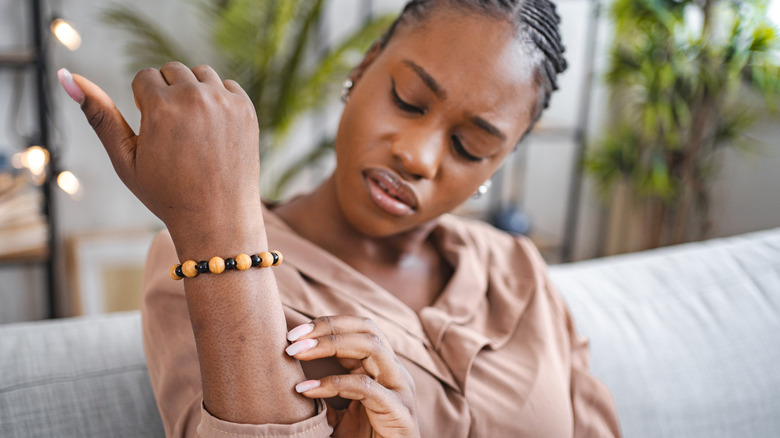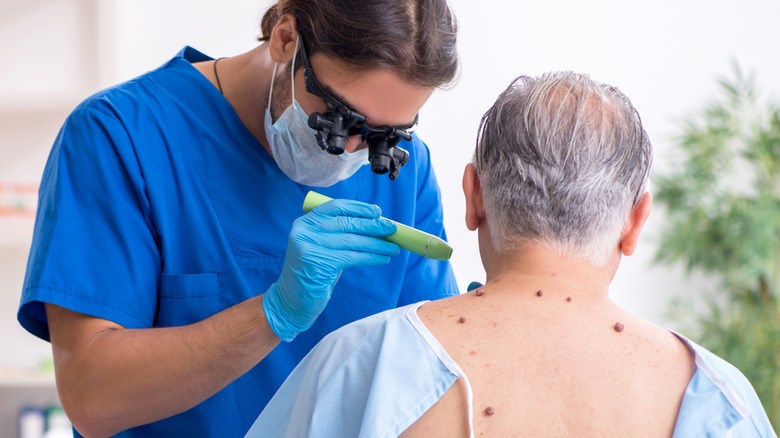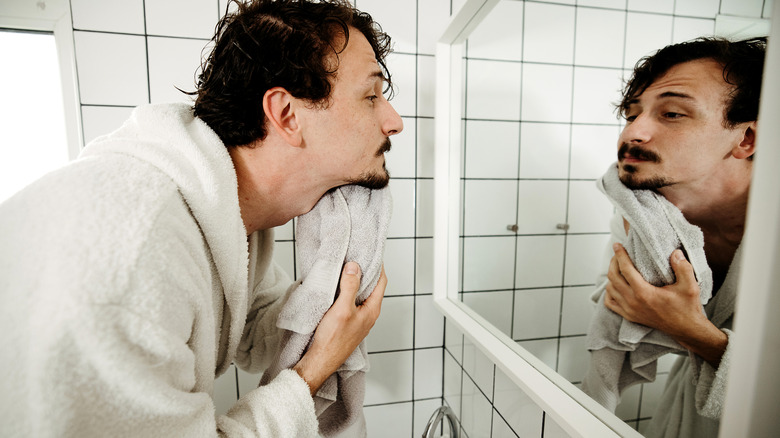If This Happens To Your Skin, You're Not Showering Enough
Everyone has gone without showering for a day or two (or seven, if you're a serious camper rather than a glamper). That's not a big deal, although dermatologist Dr. Mary Stevenson explained that "most people, by day two or day three, are not clean" (via Time).
In other words, focus on what your body needs because when you start to shower less frequently, your skin will send up red flags. (This is what happens to you when you stop showering.) For instance, your skin might start to develop scaly patches or become discolored in places. It may even start to look dirty because of hyperpigmented spots. It's not dirt, though. If you reach that point, you might want to see a dermatologist right away who can determine if you have dermatitis neglecta.
Dermatitis neglecta involves more than just discoloration or irritation of your skin. It's reflective of significant inflammation and irritation caused by a lack of personal hygiene.
Buildup on the skin changes its appearance and texture
Dermatitis neglecta isn't necessarily commonplace, but it may be more prevalent than previously thought. According to a 2006 article in the Dermatology Online Journal, historical cases of dermatitis neglecta are presumed to have been underreported. It is unclear why, although it may be that the condition isn't as well understood among practitioners with limited knowledge of it.
But why does your skin take on a crusty, darker appearance when you stop showering routinely? The answer lies in the way that your skin sheds. Every few weeks, all the dead skin cells slough off. Showering helps this process along, even if you don't use an exfoliant. Therefore, when you aren't showering, those cells are likely to remain on the upper layer of your skin. Over time, they will naturally combine with all the bacteria, sweat, oils, and grime your skin encounters. And a layer of tough buildup will begin to appear.
Of course, you shouldn't treat this as a reason to go overboard and start showering all the time or overusing exfoliant gloves. (There are many problems that happen when you exfoliate too much.) If you do, you can strip your skin of its natural moisture barrier and wind up with cracked, dry, and irritated skin. It's best to aim for the Goldilocks frequency of "just right," with the knowledge that what's right for you might be different from what's right for other people.
Identifying the underlying cause of a skin problem
You are unlikely to get dermatitis neglecta overnight or even in just a couple of weeks; it takes much longer to develop. A 2015 study in the Indian Journal of Dermatology explored three cases of dermatitis neglecta. In one of the cases, the affected individual had not cleaned a part of her body for no less than three to four months. (As a side note, the woman had gone through surgery and was worried about causing an infection in the area, which is why she stopped washing it.) Fortunately, the skin treatment for dermatitis neglecta is fairly simple. Most people can resolve skin issues that are related to dermatitis neglecta with regular cleaning and, in stubborn or severe cases, alcohol-based wipe-downs or administration of topical agents.
As an aside, sometimes dermatitis neglecta can be a sign of an underlying mental health disorder and not just a desire to live a more "au naturel" lifestyle. In fact, a 2020 report in Psychosomatics looked at five cases that fell into this category. The report concluded that dermatitis neglecta and its related habitual self-neglect behaviors might indicate impairment of lowered cognitive capabilities that could be diagnosed and treated, including with any key micronutrients that the individuals were lacking, like vitamin D.


